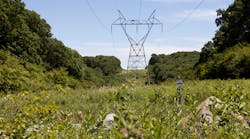The excessive release of greenhouse gases (GHG) can cause various issues for utility right-of-way (ROW) managers. In addition to contributing to extreme weather that can compromise the integrity of utility infrastructure, GHG emissions also exacerbate drought conditions, which increase the risk of wildfire.
Nearly 6 million miles of local distribution and high-voltage transmission lines weave throughout the United States, and vegetation managers have relied heavily on mechanized mowing to control invasive plants and incompatible trees throughout utility ROW for years. But here’s the problem: every thousand acres treated with mechanized mowing releases approximately 175,000 pounds of carbon dioxide (CO2) emissions into the atmosphere. As vegetation managers explore strategies to offset the negative impact of these detrimental results, Corteva Agriscience is working to help industry professionals significantly reduce GHG emissions as part of the organization’s 2030 Sustainability Goals.
With the help of industry partners, Corteva has detailed the economic and ecological downfalls of exclusive mowing practices for years. The organization has served as a funding partner of the State Game Lands 33 research project for decades, and findings from a complementary study conducted by research partner Asplundh Tree Expert revealed that herbicide applications not only produce significantly fewer carbon emissions than mowing practices, but also require significantly less time to complete. As a result, vegetation managers are encouraged to consider the benefits of improving mowing results and reducing carbon emissions by using both strategies as part of an Integrated Vegetation Management (IVM) program.
Using selective herbicide applications to precisely control problematic trees and other incompatible vegetation throughout utility ROW does more than help vegetation managers effectively reduce their carbon footprint. It also can support the development of desirable low-growing plant communities that prevent the reestablishment of problematic plant species, reduce maintenance input costs and support the development of biodiverse habitat for native wildlife species.
For example, TerraVue® herbicide from Corteva offers the industry’s most favorable environmental profile. TerraVue is powered by Rinskor® active, a reduced-risk herbicide that won the American Chemical Society’s Green Chemistry Challenge award. Selective herbicide applications featuring TerraVue can help utility vegetation managers not only control more than 140 broadleaf weeds and brush species but also minimize off-target control issues. These applications also help vegetation managers embrace the best management practices indicated by the Asplundh Tree Expert carbon study.
For more information on SGL 33 research and the benefits IVM programs provide to utility vegetation managers, native wildlife and adjacent communities, visit HabitatWithHerbicides.com.
™ ® Trademarks of Corteva Agriscience and its affiliated companies. Rinskor® is a registered active ingredient. Under normal field conditions, TerraVue® is nonvolatile. TerraVue has no grazing or haying restrictions for any class of livestock, including lactating dairy cows, horses (including lactating mares) and meat animals prior to slaughter. Label precautions apply to forage treated with TerraVue and to manure and urine from animals that have consumed treated forage. TerraVue is not registered for sale or use in all states. Contact your state pesticide regulatory agency to determine if a product is registered for sale or use in your state. Consult the label for full details. Always read and follow label directions. © 2022 Corteva.
Sponsored By:



